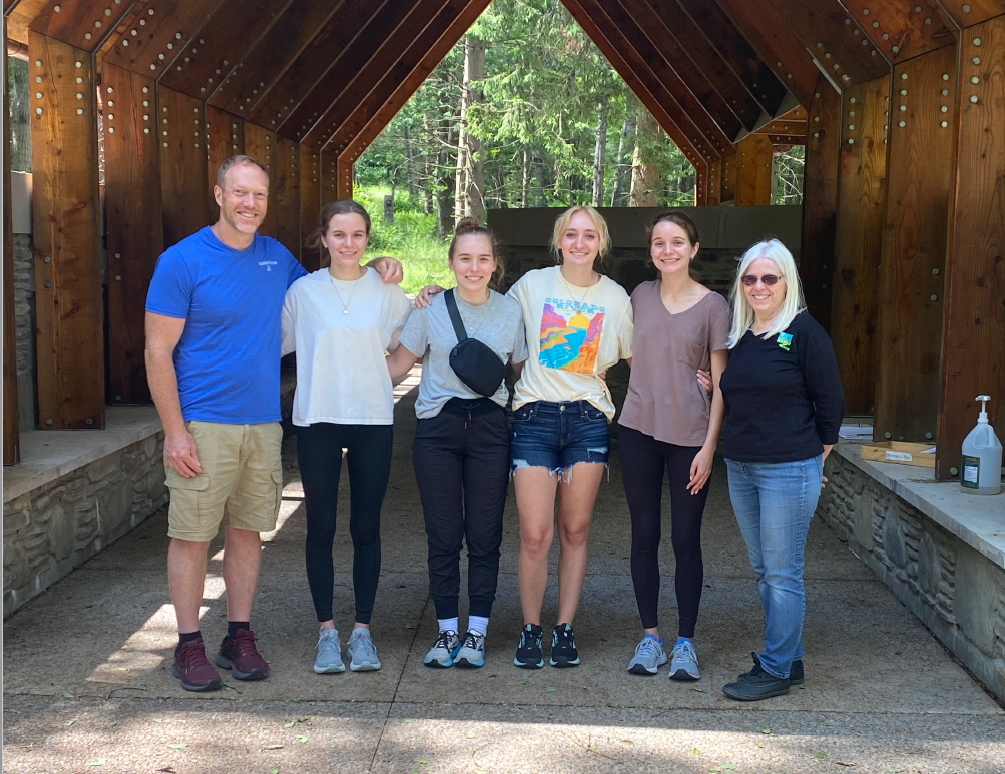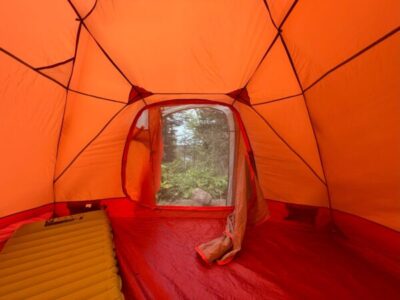
Multiple studies and countless anecdotal accounts document the calming and healing effects of spending time in nature.
But for people with autism spectrum disorder, the great outdoors can be full of dangers and stressors, from unpredictable and rough hiking trails to the overwhelming stimuli of people and animals to the risky allure posed by water.
Retired educator Loren Penman and a neighbor whose grandson is autistic mulled over these issues in a “casual conversation” that ended up sending Penman on a “seven-year quest” culminating in the opening of the Autism Nature Trail in New York’s Letchworth State Park last fall.
The mile-long trail gives people with autism and their families a safe, enjoyable way to experience the park famous for its many waterfalls, overlooks, campground, and miles of hiking trails. Therapists and other experts helped design the trail with stations and features meant to spark creativity and appreciation for nature while shielding visitors from overwhelming stimuli, uncertainty or physical risk.
The trail’s website features social stories, maps and other tools to prepare visitors, crucial for avoiding anxiety and crisis for autistic people.
Now leaders at other state parks in the Great Lakes region are exploring similar projects, as awareness about autism and the need to create accessible spaces grows nationwide, a trend reflected by the recent release of the documentary “In a Different Key” by journalist Caren Zucker. Zucker befriends and chronicles the life of the first person ever diagnosed with autism, and contrasts his experience with that of her own autistic son.
“Autism itself isn’t a disability, it’s the mismatch between their skillset and the environment,” said Dr. Amy Laurent, a developmental psychologist and pediatric occupational therapist and part of the team who created the trail. “We’re at a really exciting place now where more people are understanding that and accessibility is a bigger conversation.”
Laurent and Dr. Jacquelyn Fede, who is autistic, are partners in Autism Level UP!, an initiative which aims to empower autistic individuals and increase accessibility and awareness around neurodiversity.
Fede explained why she is deeply attracted to nature.
“The lighting is right. The sounds are right. The scents are right. There are patterns and there is logic. It is everything artificial environments are not and more. It supports and houses creatures and it has no unrealistic rules or expectations for me. Everything is just right.”
Coming full circle
The National Park Service has in the past few years added accommodations for those with Autism Spectrum Disorder to its accessibility initiative, including offering an access pass allowing free entry to almost all national parks.
While the National Park Service’s efforts are still nascent, writer Judith Newman – who raised a son with autism – noted in National Geographic that the tourism organization Visit Visalia last year earned a Certified Autism Center designation from an accreditor of training programs for those with cognitive disorders, a promising sign for visitors to nearby Kings Canyon and Sequoia national parks in California.
While the Great Lakes states have fewer large national parks than western states, the Letchworth trail shows how private citizens, organizations and state and local agencies can lead the way.
Penman’s conversation about autism and nature mushroomed into a full-blown project after she developed the idea with fellow retired educators Susan Hernstein and Gail Serventi; they called themselves the three “ANT Aunts” in reference to the acronym for Autism Nature Trail (ANT).
They enlisted the support of Temple Grandin, the prominent writer, autism activist and Colorado State University professor of animal sciences. They began fundraising and working with the New York State Parks commissioner, ultimately raising more than $3 million from private donors. Penman estimates that another million dollars is needed to create an endowment that can ensure the trail is maintained in perpetuity.
“New York State Parks was certainly in support of the concept but there was zero money both in capital and operations,” Penman said. “They said we can give you some land and park amenities that go with it – a nature center close by, things like wifi and land lines, access to park police, parking, nice restrooms; but we had to raise the money privately to do the rest of it.”
The nature trail had its ribbon-cutting on October 1, 2021; Hernstein, 83, had passed away a few weeks prior from Covid.
At Hernstein’s service, Penman said: “”While it’s true we will have a ribbon cutting for the Autism Nature Trail without Susan in a few weeks, it’s inaccurate to say she won’t get to see the finished trail. In fact, she’s been able to see in her mind the whole thing for seven years; it’s the rest of the world that finally will be able to share her vision.”
The wide, smooth trail is a loop with a cut-through in case someone becomes overwhelmed midway through the hike. Thirty-eight trailside stone markers provide stability and order, and visiting eight activity stations – including the music circle, reflection knoll and meadow run and climb — offer different experiences and a sense of accomplishment.
“It’s predictable, you’re not going to get lost,” said Penman. “The stations are [stimulating] not just the five senses – like the sensory garden where you touch and smell – but also ones built to heighten sensory perception and integration.”
The trail has proven wildly popular with locals and visitors traveling long distances, Penman said. The trail is not limited to autistic people; rather it has been an asset for older visitors, those with mobility challenges or visual impairments and others who appreciate the controlled and welcoming yet natural environment.
“It was designed specifically for persons on the spectrum but it turned out to be absolutely marvelous for everyone,” Penman said.
To try to make sure the trail’s popularity does not become an impediment to autistic people, they post when larger groups will be visiting, require that dogs be well-behaved and leashed, and provide nooks off the trail where people can go for some isolation.
Education and commerce
When Perry Central School District superintendent Daryl McLaughlin learned about the planned trail, he immediately saw it as a valuable resource for local students and families in keeping with the district’s own focus on serving autistic students.
“Several years ago, when we were taking a look at our classification rates specifically for autism spectrum, we were noting increases in numbers and in particular grade spans,” he said. “Any time we see something like that, we look at it as a fantastic opportunity to develop classroom settings that can accommodate.”
The district became a partner on the trail and created a staff position to serve as a liaison, also launching an initiative to help local businesses become more accessible to autistic people.
“We’re looking at this as a significant paradigm shift for not just individuals interacting with the trail itself, but the amenities surrounding the trail,” he said. “We’re providing professional development to the businesses in the area. Families plan their entire trip around visiting this amazing natural resource, and they would like to get a bite to eat, they would like to get ice cream.”
The first business to sign on was Butter Meat Company, an organic meat shop. Jill Gould had chosen Perry to open her business based on her fond childhood memories of visiting the area, and she launched the business in February 2020 just before the pandemic.
“I was new to the community, Loren knocked on my door when I was moving into my shop,” Gould remembered. After she attended a tour of the trail site, she was highly impressed.
“I knew it was important,” she said. “We have an organic farm, we sell organic beef, we have to be friendly and approachable and accessible. This made sense to me.”
Working with the school liaison, the shop adopted a visual ice cream menu that lets people point out what they want; a basket of fidget spinners to help with anxiety, and noise-canceling headphones to drown out the drone of the ice cream machine.
“It’s about small, appropriate very manageable steps – little things that can have big impact on your ability to provide services to neurodiverse individuals,” McLaughlin said. “We’ll provide businesses with social stories – for example if this business has antique tin roofs, it can get kind of loud, so the teacher will provide a social story about some of the things they’ll see and hear.”
Penman added that other local attractions are also amenable to people with autism, namely a drive-in theater which allows families to control the environment in which they watch a movie, and an affiliated historic gold mine where people can pan for gold.
This spring the trail will host a prominent New York City-based puppet theater doing a show specially designed for the space, as part of the area’s larger puppetry festival.
Expanding reach
Officials at Green Lake State Park near Syracuse, another of the state’s most popular parks, are exploring the possibility of creating their own autism nature trail or similar project. Park manager Ben Morse formally proposed the idea after he and another manager visited Letchworth State Park.
“We absolutely loved it,” he said. “It’s definitely something we want to work towards getting.”
He noted that a peaceful pine grove with its own parking area, well removed from the park’s lakeshore and busy areas, could be an ideal spot.
Students from Allegheny College – Penman’s alma mater – are also pitching the idea of autism nature trails. Mike Williams, director of a community-based research organization, proposed that four Allegheny students study and market Letchworth’s trail as a summer project, and he was pleasantly surprised to learn of Penman’s connection to the college.
Thanks to the students’ presentation, managers at Pymatuning State Park in Pennsylvania are considering the idea, a potential asset for the park not far from Pittsburgh that is especially known for its invasive carp-filled spillway.
“This is really magical – you just feel yourself caught up in something,” Williams said, noting students majoring in economics, English, psychology and environmental science brought their various perspectives to the project. “We’ve done some general mapping, we have a GIS lab on campus, I’m looking at all these other projects that could come out around the aesthetics and artistic dimensions. Things like this can come together in a serendipitous way.”
Creating and maintaining autism-friendly natural areas can be expensive, at a time when many Great Lakes local and state agencies are strapped for funds and dealing with countless other challenges including adapting to climate change. Accessibility for autistic people can be especially tricky in natural spaces based around the Great Lakes, since autistic people may be especially attracted to water but unprepared for the danger it presents.
As “In a Different Key” showcases, autistic people of color face particular hurdles, from racism embedded in medical and educational systems to the fear that autistic people of color could be killed by law enforcement misunderstanding their behavior. National parks meanwhile have long been less visited by and less accessible to people of color, creating a double challenge in making natural areas welcoming to autistic people of color.
But accessibility advocates hope that increasing awareness will mean more opportunities for autistic people from all backgrounds to enjoy the enriching and healing powers of nature. Laurent and Fede noted that even small steps can go a long way.
“Anything a venue can do to make the environment more known and predictable – even a quick video on the website that shows the features of your park or trail, or a map with photos of what you’ll see,” advised Laurent.
And Fede, who was deeply involved in creating the Autism Nature Trail, noted that: “Anything designed for a population will be best designed by that population. They know their own needs and preferences. I’d go so far as to say, if you haven’t included the population you claim to serve, you haven’t done anything for them at all.”
Catch more news at Great Lakes Now:
Extinctions, shrinking habitat spur ‘rewilding’ in cities
Great Lakes Moment: Detroit’s benefits of a national urban park in Windsor
Featured image: Community educator Michael Williams (left) connected Allegheny College students Kelsey Anderson, Haley Pageotte, Ela Williams and Emma Anderson (left to right) with trail co-founder Loren Penman (right) to pitch the trail concept to other parks. (Photo courtesy of Michael Williams)
1 Comment
-
This is a terrific article, with some good connecting interviews with local educators and businesses as well as an exploration of other opportunities in the region to replicate the ANT.




